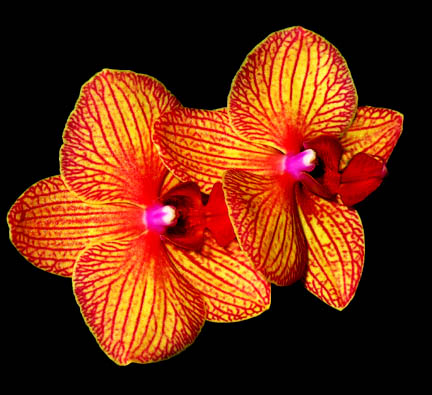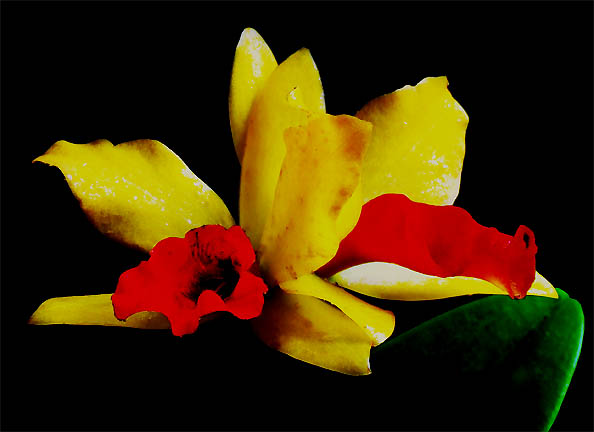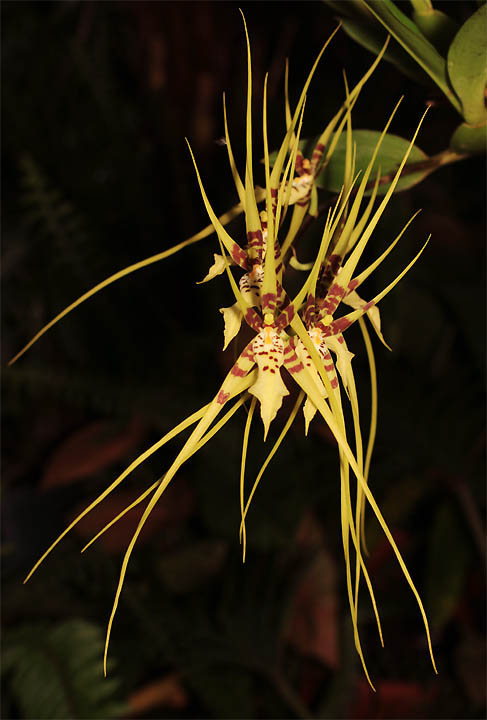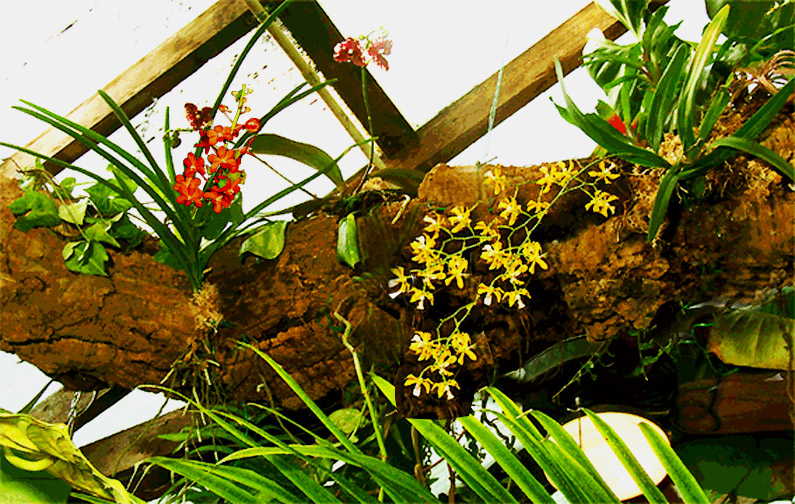![]()
Aroids and other genera in the Collection
Take the Tour Now?
Orchids
The Exotic Rainforest
Orchids
Note: "Just add ice cubes?", not a smart idea!
If you've seen the Kroger store (or any other store) orchids that tout to just add ice cubes, forget it!
That is little more than a sadistic way to kill a beautiful orchid while "donating" your money to the store and the promoter.
Phalaenopsis orchids live in a rain forest and ice on the roots will kill your orchid!!
We once lost 200 orchids in a single night as a result of a light freeze!
Just read this article and you'll learn how orchids grow in nature and it isn't anywhere near a freezer!
They are misted almost daily!
Click the photo for more information
 Internet
searchers often find this page because they want to know if orchids live
in a rain forest and can they over water a plant.
Yes, all tropical orchids are rain forest plants, and yes, it is
possible to over water but it is difficult!
Internet
searchers often find this page because they want to know if orchids live
in a rain forest and can they over water a plant.
Yes, all tropical orchids are rain forest plants, and yes, it is
possible to over water but it is difficult!
Several years ago I had a wonderful visit by a couple who drove over 200 miles to see our Exotic Rainforest and like many people these people were "orchid nuts". During our visit the couple asked a question I found to be a bit strange, "Do you misted your orchids?" A well meaning orchid grower near their home had told them that misting orchid flowers and the orchid leaves would kill the plant and flowers. They were also led to believe that hot temperatures and high humidity would also kill their plants. I've heard this so many times I wanted to laugh out loud. Orchids live in rain forests and obviously that lady has never read a book on photosynthesis! Rain water falling on the leaves of a plant are absorbed into the leaf and utilized to produce food for the plant. Without the water on their leaves photosynthesis is reduced as will be explained shortly.
So will
it? Can you mist your orchids? Does it kill the plant? Do orchids hate
heat?
Have you ever been to an Asian or
tropical rain forest is South or
Central America to watch it rain?
 I'd be willing to bet the well meaning grower who passed along this
information has never seen a tropical rain forest or studied rain
forest botany, but I have. I've
seen them in Central
America, South America, the Caribbean, the South Pacific and Southeast
Asia. Most of them have temps reaching the high 90's F and near 100%
humidity most of the summer and the balance of of the year the humidity
still swelters!
I'd be willing to bet the well meaning grower who passed along this
information has never seen a tropical rain forest or studied rain
forest botany, but I have. I've
seen them in Central
America, South America, the Caribbean, the South Pacific and Southeast
Asia. Most of them have temps reaching the high 90's F and near 100%
humidity most of the summer and the balance of of the year the humidity
still swelters!
A
gentleman I exchange email with owns an orchid nursery in Panama and one of the
most prolific orchid rain forests in the world
is in Panama. That rain forest is in the wettest portion of Panama and it rains every
day for at least 9 months year year. The ground is always muddy and
the weather is constantly sticky hot! Every single tree has orchids growing on
the sides of the trunk and there are always orchids in bloom with
perfectly beautiful flowers!
So I ask, if misting your orchids
will kill the plant and the flowers how in the world are there so many
orchids in bloom in this and other rain forests around the world? Has
God figured out a way to make the rain drops magically miss every single flower
and leaf? The answer is obviously no! If
all the flowers were destroyed by water there would be no orchid plants
in the wild! Orchids reproduce when a flower is pollinated and if
all the flowers dropped due to rain there would be zero pollination!
If there was no pollination there would be no new seeds and thus no new
plants! Eventually every orchid in the world would die and all
orchid species would vanish!
Now, I know what that
grower's response will be. They would say that orchids grown in
captive growth are not like orchids growing in the wild. To that I
would ask, how are they different? There is no difference in their
DNA with the exception
some of our orchids are hybrids.
If you go to a tropical
rain forest and watch it rain on the plants you'll quickly see the orchid
plant is
 designed to funnel the water toward the roots. That's because
almost all of the orchid types we love to grow do not grow in the soil,
they are epiphytes (ep-a-FITE) and grow on the sides or branches of trees. Those leaves were
designed to do several things, one of which is to capture light and the
other is to funnel water!
designed to funnel the water toward the roots. That's because
almost all of the orchid types we love to grow do not grow in the soil,
they are epiphytes (ep-a-FITE) and grow on the sides or branches of trees. Those leaves were
designed to do several things, one of which is to capture light and the
other is to funnel water!
Plants grow on trees in order to access brighter light since the brighter light allows the plant to produce more chlorophyll. Chlorophyll is the green pigment in the cells of every plant leaf that captures sunlight to produce photosynthesis. Plants draw in carbon dioxide and though a process known as being autotrophic and they combine CO2 with water that enters the cells of the leaf as a result of rainfall. Autotrophs literally create their own food by utilizing photosynthesis.
The process is completed through the reduction of carbon dioxide by adding the hydrogen component of water (H2O) to create organic compounds. What is reduction? Reduction is the process of dividing the CO2 from the oxygen (02) In green plants and an autotroph converts physical energy from sun light by combining the CO2 with the chlorophyll and converts it into carbohydrates in the form of sugars. They may also form chemical energy by synthesizing complex organic compounds from simple inorganic materials in order to produce fats and proteins from light. Water on the leaves plays an important role in the life of the plant!
The products of photosynthesis produced in the leaf are both sugar (carbohydrates) and oxygen and the oxygen is given back to the environment while the carbohydrates are used to feed the plant's own growth. Although home growers rarely understand the need for brighter light and high humidity to grow their plants, stronger light and at least some misting or high humidity are essential to healthy growth. It should also be understood plants also need oxygen and draw it in through their roots. However, plants don't "manufacture" oxygen as is commonly stated on the internet. Instead, photosynthesis utilizes the CO2 and then releases the oxygen (O2). If you insist on never misting an orchid you are depriving the plant of some of its ability to produce its own food!
If you somehow believe this information to be inaccurate purchase a copy of Photobiology of Higher Plants by Maurice S. McDonald. however, you should be aware the cover price is $280.00.
Even though the plant is growing attached to the tree, the roots simply cling to the tree and dangle in the air. As a result the plant has to deliver as much of the rainwater as possible to those roots because they can't soak it up enough of it to store from anywhere else! The roots then transfer it to the pseudobulb (in the case of orchids that have pseudobulbs) and then store it for use as needed by the plant. The leaves are quite efficient at both creating food for the plant as well as funneling all the rain they possibly can down to those dangling roots! Much of the time in the rain forest many plants are in bloom!
Guess what? The rain does not kill the flowers! it makes them grow and be more wonderful!
We lived in Miami, FL for
over 20 years. There are large orchid growers with thousands and
thousands of orchids all over South Florida. We grew our orchids in
the back yard, in the rain! Almost everyone in that area grows
them in the yard! Virtually all of the commercial growers
have overhead misting systems to water their plants! Many water 4 or
5
times a day for 5 to 10 minutes at a time. They don't stop misting
when a plant blooms! That's why they have so many
 fat orchids in bloom
and why people like you and me pay them high prices for their beautiful
orchids! Getting water on your orchid's leaves and flowers will not kill
either! If it would there wouldn't be any major orchid grower anywhere
using this watering technique!
fat orchids in bloom
and why people like you and me pay them high prices for their beautiful
orchids! Getting water on your orchid's leaves and flowers will not kill
either! If it would there wouldn't be any major orchid grower anywhere
using this watering technique!
So the next time a well meaning orchid person tells you to only water the potting media of your plant and to do it only every 7 to 14 days just ask yourself: Does God grows his orchids that way? Did He create them to grow that way? Guaranteed, He doesn't and didn't! Mother Nature gives them lots and lots of water and they thrive better than any orchid grower on earth could imagine! That's why orchids live in a RAIN forest!
We mist our orchids almost every day, especially during the summer, with the exception of only the winter when we water 2 or 3 times a week! True, a leaf dies every now and then but that is natural. It has nothing to do with getting water on a leaf!
The only way
I know to over water an orchid is to allow it to sit in water.
 Every orchid flower you see on this website
has had water sprayed on it during its life! Some even show water drops
in their photos and we sometimes have flowers live for 2 months! Don't believe everything you hear about
orchids and use your common sense. Most orchids
love rain!
Every orchid flower you see on this website
has had water sprayed on it during its life! Some even show water drops
in their photos and we sometimes have flowers live for 2 months! Don't believe everything you hear about
orchids and use your common sense. Most orchids
love rain!
Sorry, saying not to mist an orchid is just a myth.
As it says at the top of the
homepage of this website:
"Much of what we
believe is based on what we have yet to be taught. Listen to Mother
Nature. Her advice is best."
You can buy some of the
finest orchids in the world from Ecuagenera. Ecuagenera is an
Ecuadorian company that grows 2500 species of South American orchids and
will ship directly to you from the numerous orchid shows at which they
display each year.
We know the owners personally and know they provide incredible plants at
at prices you won't believe. You can see their plants by visiting
the Ecuagenera website:
Ecuagenera
